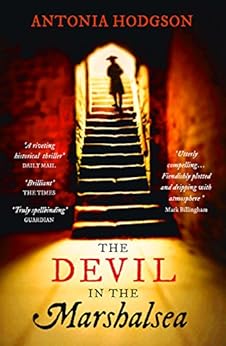- Mformat: Kindle (Amazon)
- WINNER OF THE CWA HISTORICAL DAGGER AWARD 2014.
- File Size: 929 KB
- Print Length: 401 pages
- Publisher: Hodder & Stoughton (March 27, 2014)
- Publication Date: March 27, 2014
- Sold by: Hachette Book Group
- Language: English
- ASIN: B00FAT9IJK
The first thrilling historical crime novel starring Thomas Hawkins, a rakish scoundel with a heart of gold, set in the darkest debtors’ prison in Georgian London, where people fall dead as quickly as they fall in love and no one is as they seem.
London, 1727. Tom Hawkins refuses to follow in his father’s footsteps and become a country parson. His preference is for wine, women, and cards. But there’s honor there too, and Tom won’t pull family strings to get himself out of debt—not even when faced with London’s notorious debtors’ prison.
The Marshalsea Gaol is a world of its own, with simple rules: Those with family or friends who can lend them a little money may survive in relative comfort. Those with none will starve in squalor and disease. And those who try to escape will suffer a gruesome fate at the hands of its ruthless governor and his cronies. The trouble is, Tom has never been good at following rules, even simple ones. And the recent grisly murder of a debtor, Captain Roberts, has brought further terror to the gaol. While the captain's beautiful widow cries for justice, the finger of suspicion points only one way: to the sly, enigmatic figure of Samuel Fleet.
Some call Fleet a devil, a man to avoid at all costs. But Tom Hawkins is sharing his cell. Soon Tom’s choice is clear: get to the truth of the murder—or be the next to die.
A dazzling evocation of a startlingly modern era, The Devil in the Marshalsea is a thrilling debut novel full of intrigue and suspense.
My Take
Debtors' prison in 1727 is very different to what we in the 21st century might expect. Those who enter will never truly be free of debt for if they live to serve their sentence they will still have incurred debts in merely surviving. In many cases the debt to the prison will be greater than that for which they were originally imprisoned. Whether they survive or not really depends on whether they in the Common prison or not. Many of those not in the Common Side of the prison are free to leave during the day to carry on commerce, to conduct business and earn money that will enable them to pay for their prison accommodation. They must return to the prison each night. In this system those housed in the Common Side will not survive more than a few months.
It is unusual though for wealthier prisoners like Captain John Roberts to die, and the authorities announce that he has committed suicide, although his wife firmly believes he has been murdered. Rumours abound that his ghost is roaming the prison and that it requires that his murderer be exposed. The prison authorities recognise the unrest this is causing.
Tom Hawkins finds himself charged with identifying Captain Roberts' murderer. If he does he will be released and pardoned, but if he doesn't he will die in the Common Side.
The true value of this book lies in the wealth of historical detail. Many of the characters used are based on true figures, and the situations in which they are found really happened.
My rating: 4.6
About the author
Antonia Hodgson (born 1971) is a British historical crime writer and publisher.
Hodgson was born in Derby in 1971. She attended Littleover Community School where she first studied the time of the early Georgians in A-level History. She graduated with a degree in English Literature from Leeds University in 1994 and she went to work for Harcourt, Brace.
Hodgson had spent nearly twenty years in the publishing business rising to editor-in-chief at Little, Brown before she published her own first novel. As an editor she had worked with Ozzy and Sharon Osbourne and the American novelists Nora Roberts and Elizabeth Kostova.
Hodgson's first novel, A Devil in the Marshalsea, was set in the time of the early Georgians, William Hogarth and the Southwark prison the Marshalsea. Hodgson believes that the Georgian period was more intriguing than the Victorian era which is usually considered to be more culturally important. The book was submitted anonymously to the publishers, Hodder & Stoughton, because she was known in the publishing industry. Her first book won the Crime Writers Association's Historical Dagger award and was long listed for a first novel award. It also was shortlisted in 2015 for the Theakston's Old Peculier Crime Novel of the Year Award.

No comments:
Post a Comment